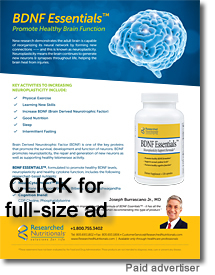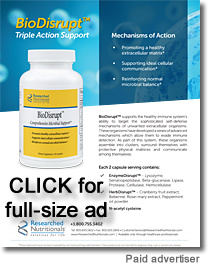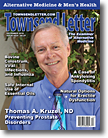|
The 2017-18 flu season will be remembered for low vaccine effectiveness, significant incidence of emergency room visits and hospitalizations, and high numbers of influenza-associated pediatric deaths (n=174).1,2 Of the previous fourteen seasons for which the CDC has been monitoring mortality rates, only 2009-10 witnessed a greater number of pediatric deaths (n=288).3 With another flu season upon us, healthcare providers and patients alike are asking, Will it be as severe as the 2017-18 season? Even if we had a crystal ball, predicting whether forehand knowledge would influence people's healthcare behaviors is difficult to say. And without debating the personal choiceto get vaccinated or not, providers should consider bovine colostrum supplementation as either a stand-alone preventative or adjunct to the flu shot.
Prior to the development of modern vaccines and antiviral medications, colostrum and raw milk from domesticated ruminant animals was utilized for centuries by civilizations across the globe. Colostrum and raw milk were and still are today a primary source of nutrition for many rural communities in developing countries. Colostrum and raw milk provide essential nutrition for growth, development, and protection against pathogenic microbes and in turn, better health for survival of the fittest among the population. Colostrum use was determined by experience not by scientific knowledge per say, but today, both play an important role in the resurgence of colostrum supplementation. There is a growing body of research that now offers evidence of colostrum's preventative and therapeutic action.
 Interest in colostrum as an influenza preventative began in the mid-2000s as Italian researchers sought to investigate new, low-cost treatments to better address the virus mutations from season to season. Cesarone et al. evaluated the efficacy of a two-month treatment with oral colostrum in the prevention of flu episodes compared with influenza vaccination and detailed their findings in a 2007 paper.4 Participants in part 1 of the study included healthy subjects who received either colostrum, colostrum plus vaccination, vaccination alone, or no prophylaxis. After three months of follow-up, the number of flu days was three times higher in the non-colostrum patients. The colostrum-only group had 13 episodes versus 14 in the colostrum plus vaccination group; 57 in vaccination-only group; and 41 in the group without prophylaxis. Part 2 of the study had a similar protocol with sixty-five very high-risk cardiovascular subjects, all of whom had prophylaxis. The incidence of complications and hospital admission was higher in the group that received only a vaccination compared with the colostrum-only and colostrum plus vaccination groups. Researchers concluded that in both healthy subjects and high-risk cardiovascular patients, colostrum is at least three times more effective than vaccination alone to prevent seasonal influenza and is simultaneously cost-effective. Interest in colostrum as an influenza preventative began in the mid-2000s as Italian researchers sought to investigate new, low-cost treatments to better address the virus mutations from season to season. Cesarone et al. evaluated the efficacy of a two-month treatment with oral colostrum in the prevention of flu episodes compared with influenza vaccination and detailed their findings in a 2007 paper.4 Participants in part 1 of the study included healthy subjects who received either colostrum, colostrum plus vaccination, vaccination alone, or no prophylaxis. After three months of follow-up, the number of flu days was three times higher in the non-colostrum patients. The colostrum-only group had 13 episodes versus 14 in the colostrum plus vaccination group; 57 in vaccination-only group; and 41 in the group without prophylaxis. Part 2 of the study had a similar protocol with sixty-five very high-risk cardiovascular subjects, all of whom had prophylaxis. The incidence of complications and hospital admission was higher in the group that received only a vaccination compared with the colostrum-only and colostrum plus vaccination groups. Researchers concluded that in both healthy subjects and high-risk cardiovascular patients, colostrum is at least three times more effective than vaccination alone to prevent seasonal influenza and is simultaneously cost-effective.
A 2010 study by the same Italian team evaluated the efficacy of a combined oral colostrum and probiotic supplement (collectively referred to as immunomodulators) compared to influenza vaccination in healthy subjects.5 Similar results were obtained. Individuals receiving either colostrum plus probiotics or colostrum plus probiotics plus vaccination fared better than those receiving vaccination alone or no treatment at all. They experienced fewer flu episodes and fewer flu days. Those receiving a vaccination had twice as many flu episodes than those receiving the colostrum and probiotic supplement. Researchers concluded that using immunomodulators is both effective and practical and exceedingly valuable where the peak of flu activity is reached rapidly and/or there is a need to quickly protect healthcare workers who interact with sick patients.
Immunomodulation can be a significant strategy in the context of today's global virus behavior and the industry's inability to produce vaccines quickly on a massive scale. When combined with aversion to and/or lack of access to vaccination, bovine colostrum should be an acceptable alternative when providers and patients are adequately informed about its health benefits. Bovine colostrum contains a wide variety of bioactive components that have antiviral activity directly or indirectly stimulating the immune system to identify, isolate, and destroy viruses. The majority of colostrum's antiviral activity results from the collective action of its immunoglobulins, antibodies, lactoferrin, lactoperoxidase, and proline-rich polypeptides (PRPs).
Two primary mechanisms of action are to bind to viral pathogens and destroy their cell membranes or to compete for binding sites on the intestinal wall.6 Immunoglobulins, or antibodies, are utilized by the immune system to recognize and bind antigens; they identify and mark viral as well as bacterial cells for destruction. Immunoglobulins in bovine colostrum bind to disease-causing pathogens on the mucosal surfaces of the GI tract, thereby preventing them from colonizing and causing infection. Immunoglobulin G (IgG) is the predominant antibody in bovine colostrum, and it is the source of systemic immunity passed from cow to calf and from cow to human via colostrum. More than a dozen specific viral antibodies have been identified in bovine colostrum, including those against adenovirus, alphavirus, Dengue virus, echovirus, Epstein-Barr virus, Enterovirus 71, hantavirus, hepatitis C virus, herpes viruses, HIV-1, human papilloma virus, influenza, Japanese encephalitis, measles, polio virus, respiratory syncytial virus, rotavirus, St. Louis virus, West Nile virus, and yellow fever virus.7
 Lactoferrin is an iron-binding glycoprotein belonging to the transferrin family that has anti-bacterial and anti-inflammatory capabilities in addition to being an antiviral powerhouse. All mucous secretions of the human body contain lactoferrin, which acts as a non-specific first line of defense against disease-causing pathogens. Lactoferrin's antiviral activity has been demonstrated with respect to hepatitis B and C viruses, herpes simplex virus-1, HIV, poliovirus, and respiratory syncytial virus.8 Lactoferrin's direct mechanisms of action in killing pathogens include binding to target cells, and thus preventing the pathogens from binding; binding to the pathogens and causing them to lyse; or inhibiting viral replication once the virus has entered the target cell. The indirect mechanisms are immunomodulatory, including regulating the proliferation and activity of leukocytes, pro-inflammatory cytokines, and natural killer (NK) cells. Lactoferrin administration enhances NK cell activity as well as Th1 cytokine response which results in general protection against viruses that cause influenza and the common cold.9,10 More specifically, bovine lactoferrin's anti-influenza activity has been observed against influenza A virus H1N1 and H3N2.11-13 Lactoferrin is an iron-binding glycoprotein belonging to the transferrin family that has anti-bacterial and anti-inflammatory capabilities in addition to being an antiviral powerhouse. All mucous secretions of the human body contain lactoferrin, which acts as a non-specific first line of defense against disease-causing pathogens. Lactoferrin's antiviral activity has been demonstrated with respect to hepatitis B and C viruses, herpes simplex virus-1, HIV, poliovirus, and respiratory syncytial virus.8 Lactoferrin's direct mechanisms of action in killing pathogens include binding to target cells, and thus preventing the pathogens from binding; binding to the pathogens and causing them to lyse; or inhibiting viral replication once the virus has entered the target cell. The indirect mechanisms are immunomodulatory, including regulating the proliferation and activity of leukocytes, pro-inflammatory cytokines, and natural killer (NK) cells. Lactoferrin administration enhances NK cell activity as well as Th1 cytokine response which results in general protection against viruses that cause influenza and the common cold.9,10 More specifically, bovine lactoferrin's anti-influenza activity has been observed against influenza A virus H1N1 and H3N2.11-13
Lactoperoxidse is heme-containing glycoprotein belonging to the mammalian peroxidase family, and similar to lactoferrin, it is found in saliva, tears, airway mucous, milk, colostrum, and other endocrine secretions. When combined with its physiological substrates hydrogen peroxide and thiocyanate, lactoperoxidase achieves widespread antiviral activity; research shows lactoperoxiodase to be particularly effective against HIV, herpes simplex virus-1, respiratory syncytial virus and echovirus.14,15 Orally-administered lactoperoxidase and lactoferrin in mice infected with influenza A virus H1N1 was found to attenuate pneumonia by suppressing the accumulation of inflammatory cells in lung tissue.16 Furthermore, lactoperoxidase itself downregulated production of the pro-inflammatory cytokine IL-6 and reduced body weight loss during the infection period.
The proline-rich polypeptides (PRPs), also known as colostrinin, are a collective group of low molecular weight colostrum polypeptides that play a major role in modulating the activity of the immune system by way of the thymus gland. The thymus gland can be considered "central command" for the immune system, and PRPs have significant stimulatory and suppressive effects depending on the body's specific need at any given time. PRPs stimulate immune system activity when needed to fight off an infection or quell its activity to prevent tissue damage once the infection has been defeated or, in the case of autoimmune conditions, suppresses the inflammation.17 This dual-purpose intercellular signaling activity is beneficial in achieving the body's ultimate goal of maintaining homeostasis.
With respect to defeating influenza and other viral infections, PRPs act in a multi-pronged approach to create the immune response necessary to destroy pathogens. PRPs do this by stimulating leukocyte production; increasing blood vessel permeability in the skin to permit antibodies and other immunomodulatory cells entry into the tissue to fight infection; increasing production of NK cells and their cytotoxic activity; regulating major pro-inflammatory cytokines such as tumor necrosis factor-alpha (TNF-α) which controls the entire inflammatory cascade of cytokine activity during an infection, and gamma interferon (INF-γ) which interferes with viruses' ability to replicate; and inducing differentiation and maturation of monocytes and macrophages whose job it is to seek out pathogens18-22.
Predicting which viruses will be most prevalent in any given flu season is often "best guess" medicine. Some years, scientists and vaccine manufacturers get lucky and the public benefits. Scientific shortcomings are more apparent when young children fall victim to the flu. The fact is that young or old, living in today's world requires a strong, balanced immune system. From stress to poor nutrition to unhealthy behaviors to increasing levels of pollution and environmental toxins, the normally robust immune system becomes compromised and unable to function effectively. And with the significant increase in world travel over the past few decades, it's not surprising that viruses are earning frequent flyer miles too. Daily supplementation with bovine colostrum supports a healthy, balanced immune system that in turn, provides the best prophylaxis against influenza and other dangerous viruses.
References
1. https://www.cdc.gov/flu/weekly/weekly archives2017-2018/data/whoAllregt_cl24.html
2. Garten R, et al. Update: influenza vctivity in the United States during the 2017-18 season and composition of the 2018-19 influenza vaccine. MMWR Morb Mortal Wkly Rep. 2018 Jun 8;67(22):634-642.
3. https://gis.cdc.gov/GRASP/Fluview/PedFluDeath.html
4. Cesarone MR, et al. Prevention of influenza episodes with colostrum compared with vaccination in healthy and high-risk cardiovascular subjects: the epidemiologic study in San Valentino. Clinical and Applied Thrombosis/Hemostasis. 2007 Apr;13(2):130-136.
5. Belcaro G, et al. Prevention of flu episodes with colostrum and Bifivir compared with vaccination: an epidemiological, registry study. Panminerva medica. 2010 Dec;52(4):269-75.
6. Van Hooijdonk AC, Kussendrager KD, Steijns JM. In vivo antimicrobial and antiviral activity of components in bovine milk and colostrum involved in non-specific defence. Br J Nutr. 2000;84 Suppl 1:S127–S134.
7. Keech AM. Peptide Immunotherapy: Colostrum – A Physician's Reference Guide. 2009. AKS Publishing.
8. van der Strate BW, et al. Antiviral activities of lactoferrin. Antiviral Res. 2001 Dec;52(3):225-39. Review.
9. Yamauchi K, et al. Bovine lactoferrin: benefits and mechanism of action against infections. Biochem Cell Biol. 2006 Jun;84(3):291-6. Review.
10. Wakabayashi H, et al. Lactoferrin for prevention of common viral infections. J Infect Chemother. 2014 Nov;20(11):666-71.
11. Pietrantoni A, et al. Bovine lactoferrin inhibits influenza A virus induced programmed cell death in vitro. Biometals. 2010 Jun;23(3):465-75.
12. Ammendolia MG, et al. Bovine lactoferrin-derived peptides as novel broad-spectrum inhibitors of influenza virus. Pathog Glob Health. 2012 Mar;106(1):12-9.
13. Scala MC, et al. Lactoferrin-derived peptides active towards influenza: identification of three potent tetrapeptide inhibitors. Sci Rep. 2017 Sep 6;7(1):10593.
14. Pourtois M, et al. Inhibition of HIV infectivity by lactoperoxidase-produced hypothiocyanite. J Biol Buccale. 1990 Dec;18(4):251-3.
15. Mikola H, Waris M, Tenovuo J. Inhibition of herpes simplex virus type 1, respiratory syncytial virus and echovirus type 11 by peroxidase-generated hypothiocyanite. Antiviral Res. 1995 Mar;26(2):161-71.
16. Shin K, et al. Effects of orally administered bovine lactoferrin and lactoperoxidase on influenza virus infection in mice. J Med Microbiol. 2005 Aug;54(Pt 8):717-23.
17. Rona Z. Bovine colostrum emerges as immunity modulator. Am J Nat Med. 1998;5(2):19-23.
18. Kruzel ML, et al. Towards an understanding of biological role of colostrinin peptides. J Mol Neurosci. 2001 Dec;17(3):379-89.
19. Janusz M, Lisowski J. Proline-rich polypeptide (PRP)--an immunomodulatory peptide from ovine colostrum. Arch Immunol Ther Exp (Warsz). 1993;41(5-6):275-9.
20. See DM, et al. The role of natural killer cells in viral infections. Scand J Immunol. 1997 Sep;46(3):217-24. Review.
21. Zabłocka A, et al. Cytokine-inducing activity of a proline-rich polypeptide complex (PRP) from ovine colostrum and its active nonapeptide fragment analogs. Eur Cytokine Netw. 2001 Jul-Sep;12(3):462-7.
22. Kubis A, et al. Studies on the mechanism of action of a proline-rich polypeptide complex (PRP): effect on the stage of cell differentiation. Peptides. 2005 Nov;26(11):2188-92.


|
|
![]()
![]()
![]()
![]()







